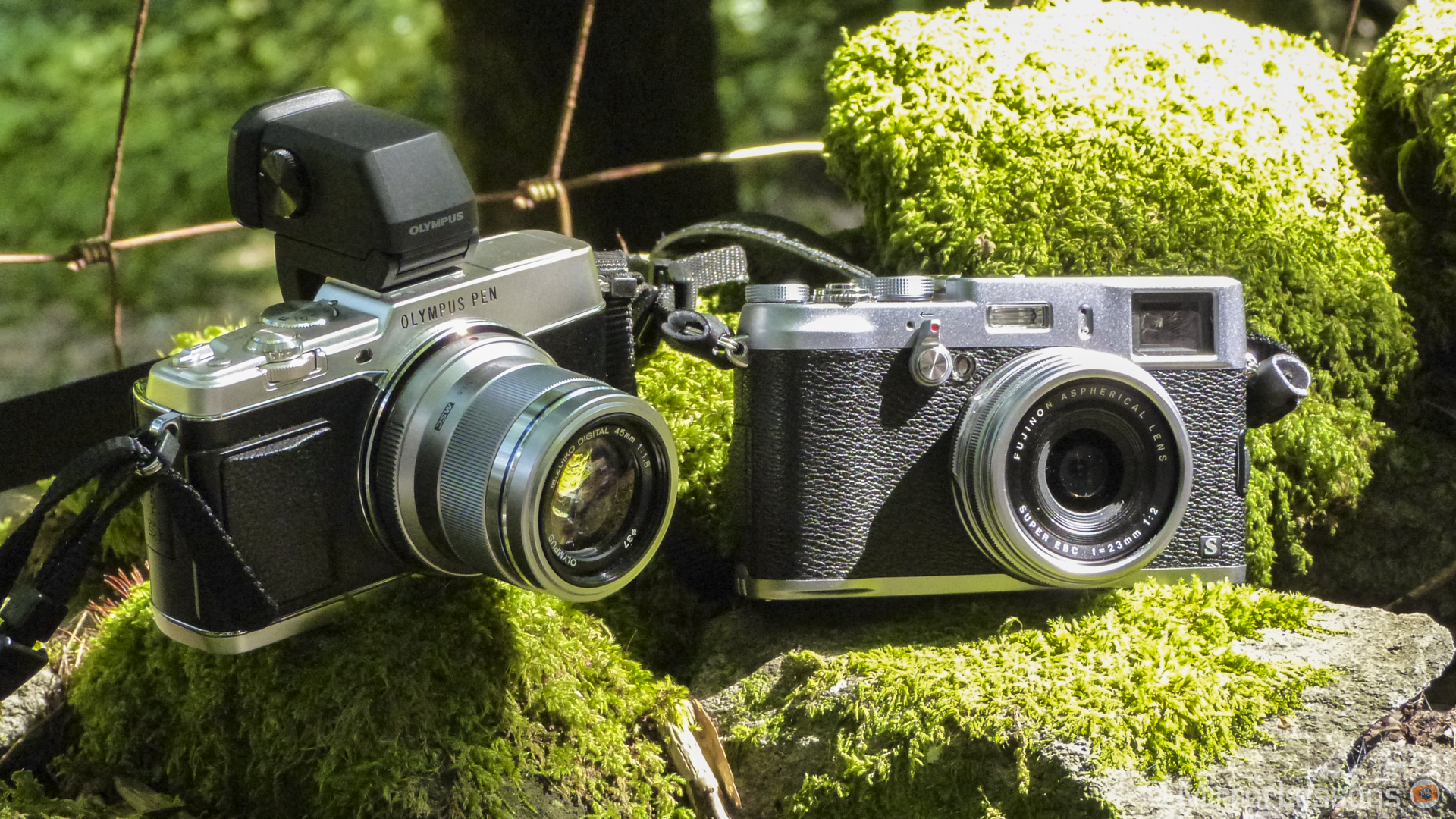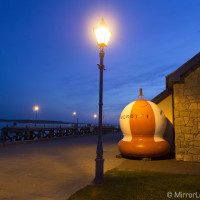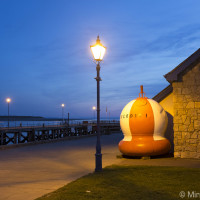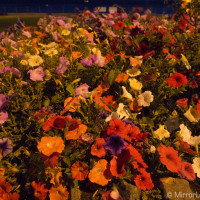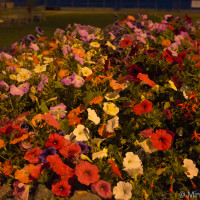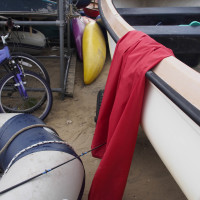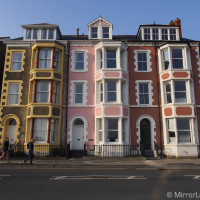A few months ago, we pitted the then brand-new Fujifilm X100s against the OM-D E-M5, Olympus’ Micro 4/3s flagship, to see which camera would emerge victorious. As it turned out, it was impossible to definitively say that one camera was better than the other as they have been designed for very different purposes. Though I risk giving away the punchline of this article in the very first paragraph, I’ll blurt it out anyway: the same stands for the E-P5 and the X100s.
The E-P5 is an MILC (mirrorless interchangeable lens camera) with a Micro Four Thirds sensor, and is very similar to the E-M5 in terms of specifications despite actually being the successor to the Pen E-P3. Thanks to its unique array of features, it can easily be considered a new reference for Olympus–that is, until the new OM-D E-M1 arrives later this year. The X100s, on the other hand, has a fixed 35mm lens and an APS-C X-Trans II sensor, and remains one of two Fujifilm flagships alongside the interchangeable X-Pro 1.
Due to its interchangeable nature, the E-P5 can be used for a wide variety of genres whereas the X100s is intended mainly for street photography. The former is faster and has better stabilisation, whereas the latter produces more attractive film-like colours.
Want to find out more about these two retro rivals? Then read on because there is much to be said!
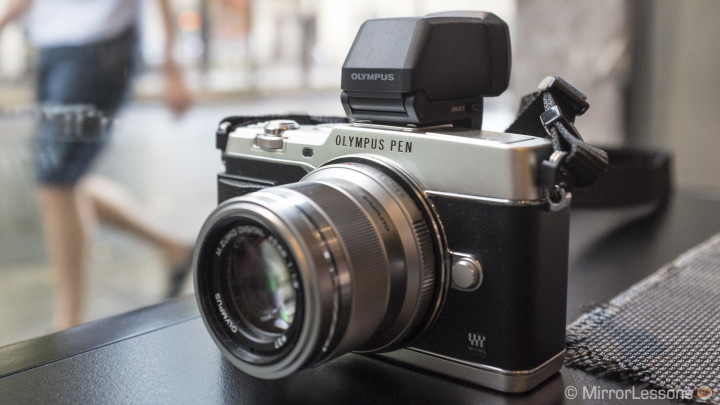
Olympus Pen E-P5
(with M.Zuiko 45mm f/1.8 and VF-4 viewfinder mounted)
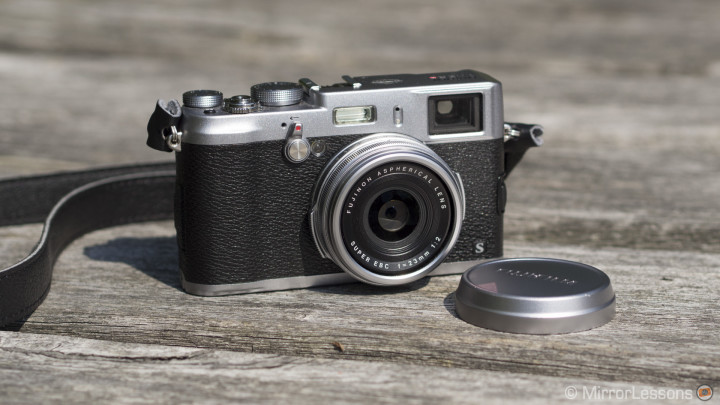
Fujifilm X100s
Main Specs
The biggest difference between these two cameras is that:
The Pen E-P5 is an interchangeable lens system camera and features a Micro Four Thirds sensor, which is two times smaller than a Full Frame sensor (35mm equivalent).
The X100s has a fixed prime 23mm lens (35mm equivalent) and features an APS-C sized sensor with Fuji X-Trans sensor technology. The sensor is bigger than M43 and is 1.5 times smaller than Full Frame.
What is the meaning of this?
First, since the E-P5 is an interchangeable lens camera, the quality of your pictures will be affected by the lens you are using. This, of course, gives the EP-5 a lot more versatility, allowing you to take a variety of different shots.
With the X100s and its fixed prime lens, you are limited to a 23mm (35mm equivalent). This isn’t necessarily a bad thing, but it reinforces the fact that this is a niche camera, designed for specific purposes and not to be used in every kind of situation (unless you are a photographer looking to push the boundaries of your creativity!).
Furthermore, they possess two different types of sensor technology. The X100s has better dynamic range and less noise at high ISO levels. Depth of field isn’t really comparable as it depends on the lens mounted on the E-P5.
[stextbox id=”text-box-toc” caption=”Main Specs” collapsing=”true” collapsed=”false”]
Pen E-P5
- Sensor: 16.1 megapixels 4/3 Live MOS
- Lens system: Micro Four Thirds interchangeable lens system
- ISO Sensitivity: 200 – 25600 ISO (extendable to 100)
- Shutter type: focal plane shutter (Max.1/8000s)
- Continuous shooting: 9 fps with single AF mode
- Autofocus: Autofocus with image contrast detection system and 35 focusing points
- Focus Peaking: Yes
- Internal Stabilisation: Yes (5 axis image stabilisation)
- Viewfinder: None (external VF can be mounted on the hotshoe)
- LCD Screen: 3.0-inch tilting LCD monitor, approx. 1037k dots, Touch control
- Movie recording: Full HD: MOV (MPEG-4AVC/H.264 ) and AVI (Motion JPEG), interlaced, up to 20 mbps
- Weather-sealed: No
- Sensor Cleaner: Yes (Supersonic Wave
- Built-in Flash: Yes
- Wifi: Yes
- Extras: Art Filters, panorama, multiple exposure
- Dimensions: 122 x 68.9 x 37.2mm
- Weight: Approx. 378g
Fuji X100s
- Sensor: 16.3 million pixels – APS-C X-Trans CMOS II
- Lens System: fixed 23mm f/2, equivalent to 35mm on a 35mm format
- ISO Sensitivity: 200 – 6400, extendable to 100, 12800 and 25600 (JPG only)
- Shutter type: leaf shutter (Max.1/4000s)
- Continuous shooting: approx. 6 fps (max. 31 frames)
- Autofocus: intelligent Hybrid AF (TTL contrast AF / TTL phase detection AF)
- Focus Peaking: Yes
- Internal Stabilization: No
- Viewfinder: Hybrid (optical and electronic)
- LCD Screen: 3.0-inch OLED monitor, approx. 610k dots
- Movie recording: 1920 x 1080 pixels (60fps/30fps) with stereo sound
- Weather-sealed: No
- Sensor Cleaner: No
- Built-in Flash: Yes
- Wifi: Yes
- Extras: Built-in ND filter, Motion Panorama, Multiple Exposure modes
- Dimensions: 126.5 x 74.4 x 53.9 mm
- Weight: Approx. 445g
[/stextbox]
Ergonomics and Design
Both cameras have inherited a retro design from old film cameras, a style which is very common and popular these days.
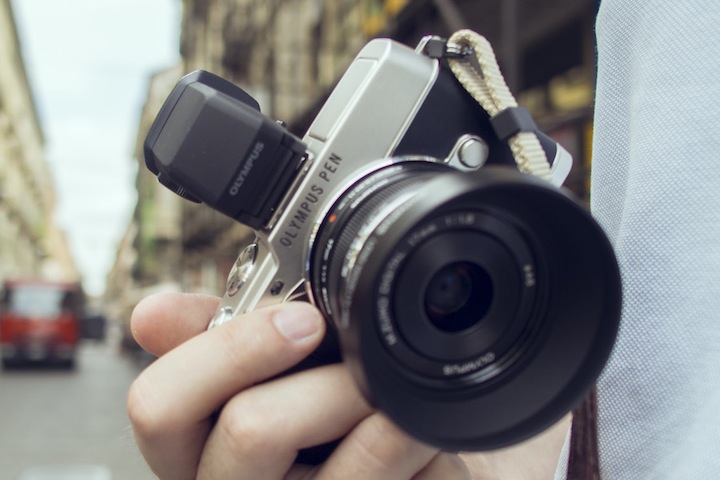
The E-P5 design is nearly identical to that of the old analog Pen series by Olympus.
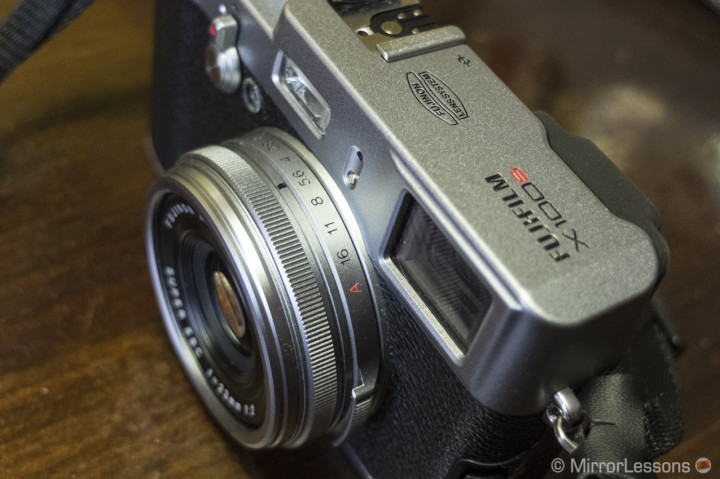
The X100s, on the other hand, takes its design from rangefinder cameras. The similarity to Leica cameras in particular is quite striking.
Both have a wonderful design and a very sturdy build with a solid metal feel. But when it comes to ergonomics…
…the E-P5 is ever-so-slightly smaller and shorter than the X100s if you don’t have the VF-4 viewfinder attached. The buttons are robust and well-placed, as are the aperture and shutter speed dials.
…the X100s is slightly larger and taller if you ignore the external VF-4 viewfinder on the E-P5; therefore it feels nicer to hold. The various buttons are very well-placed, and the shutter speed dial and aperture ring on the lens are definitely a welcome addition.
Functionality & Ease-of-use
Both cameras are easy to use but their menu systems and options are quite different.
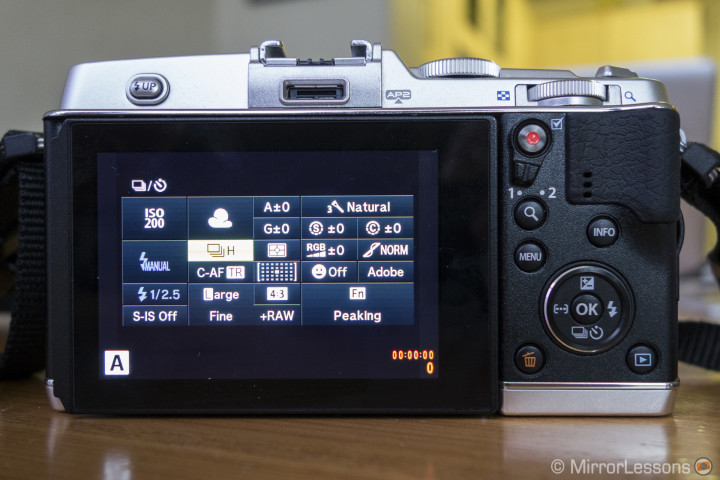
The E-P5 has a more complex and complete menu system. The main settings of the camera can be accessed with the OK button. It has one function button on the top, and an arrow pad with left and down buttons that can also be customized. There is also a handy toggle switch which allows you to change how the top dials work. The default settings allow you to change aperture/shutter speed in position 1 and white balance/ISO in position 2. The magnify and video buttons on the rear can also be customized.
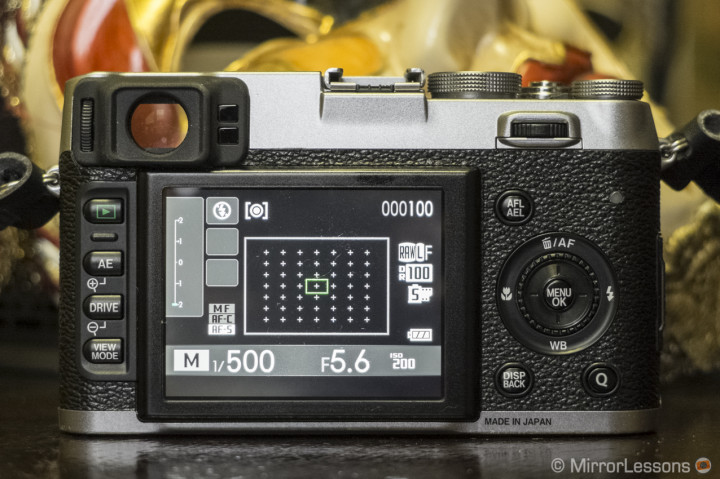
The X100s has its “Q” button where you can access in an instant all the main settings for your pictures. Furthermore, the “DRIVE” button and the AE button let you quickly access other important settings (shooting mode and exposure) on the camera. The Menu system is very simple and easy to learn. The only thing missing is an extra Fn button (it only has one).
Both cameras feature a high-quality LCD screen.
The E-P5 has the advantage of a tilting LCD screen, which is very useful for high-angle shots. It is one of the brightest and sharpest screens I have ever seen on a camera. It is also touch sensitive and while I prefer to rely on buttons for the different operations and settings, I find it really helpful to quickly change the AF focus point without using any buttons to take a shot. This is something that can make you very discreet for street photography, as people will tend to think you are playing back your pictures or adjusting your camera settings.
The LCD screen is also very nice on the X100s but has less resolution and can’t be tilted. It is not touch sensitive either.
One of the main differences between the two cameras concerns the viewfinder…
The E-P5 does not have a built-in viewfinder but you can attach the external VF-4 to the hotshoe (separate purchase). Though it tends to protrude too much from the E-P5’s compact body and limits your use of other accessories on the camera such as an external flash, it is undoubtedly the best electronic viewfinder to date.
The X100s has a hybrid viewfinder, which is one of the most interesting features of Fuji X system. You can quickly switch between an optical and electronic viewfinder. The OVF is brighter and sharper than the EVF and covers a larger area than the actual frame. However, using the OVF you have to be aware of the parallax issue: what you are seeing is not exactly what you are shooting, because the viewfinder is at a slight distance from the lens. The EVF, on the other hand, is more precise for focusing on short distances.
Both cameras have a focus peaking function for manual focus that works very well, but I find the X100s version more precise mainly because you have the option to set it to low (less highlighted outlines) or high (more highlighted outlines).
Image Quality
Both cameras deliver exceptional image quality in RAW and JPG format.

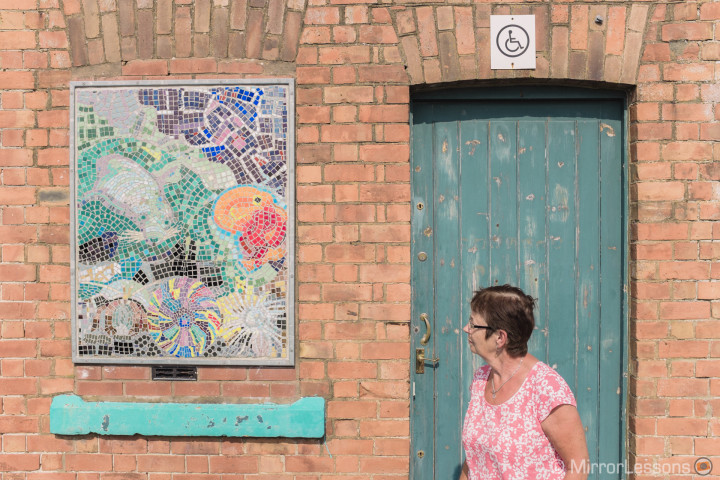
Despite its small sensor, the E-P5 defends itself very well when it comes to dynamic range and ISO performance. It has an extended Low ISO of 100, and a high ISO of 25600 for both RAW and JPGs. The RAW files are also very nice to work with and I am always surprised at the amount of highlights and shadows I manage to recover, despite the smaller sensor.
In the case of the X100s, having a larger sensor allows for better dynamic range. The X-Trans sensor is exceptional for high ISO performance. It looks less digital and has more organic noise at high ISO that I personally find more pleasant.
The RAW files are also amazing, among the best I have ever worked with. The only limit is that the extended ISO (12800 and 25600) will only work for JPGs.
As for ISO performance, you will need to view the pictures at 100% to really see the difference up to 3200 ISO. At 6400 ISO, the X100s retains more detail. At 12800 and 25600 the difference is more visible even without pixel-peeping, but both cameras do a very good job.
Below you can check out a simple high ISO comparison gallery between the two cameras. We used the 12mm f/2 on the E-P5 so the picture won’t be exactly the same in terms of composition. Otherwise, we used the same settings on both cameras.
Colour reproduction is another big difference between the two cameras, especially if you look at the JPGs, as they retain the true colours produced by the camera.
Colour reproduction is certainly a strong point for the E-P5. Colours are warm, powerful, natural and highly detailed. I don’t worry too much about the result when shooting with the vivid colour profile or in JPG as I might with other cameras, as I know the quality will be good. (This said, I still prefer working with RAW files.)
The colours of the X100s are different – I would say less “digital” than other cameras, and it is in this realm that the X100s really stands out from the crowd. The X-Trans sensor has that ‘something extra’ when it come to tonal range that closes the gap with film. The colour reproduction produced by the Film Simulation Modes (the picture profile in other cameras) is also wonderful – I have a particular fondness for the Astia mode.
Below is an informal gallery with samples from the two cameras to show some of the differences.
Of course, one of the main differences is the lens system.
The E-P5 is an interchangeable lens system camera: the quality of your pictures can vary a lot depending on the lens you are using. Primes are better, like the wonderful M.Zuiko 12mm f/2, or the M. Zuiko 45mm f/1.8. Some criticize M43 cameras for having poor bokeh capabilities, but if you mount a good lens on it, you won’t be disappointed.
You can also visit these additional E-P5 galleries:
The fixed Fujinon 23mm f/2 (35mm equivalent) limits the usability of this camera, as it has been designed primarily for street photography. The lens is fairly sharp at its fastest aperture, and become razor-edged from f/4, revealing the great sharpness capabilities of the X100s. At times, it has a little bit of distortion. It is overall a nice lens but it isn’t the greatest feature of the camera and it certainly won’t be the reason you buy the x100s. But the fact that the X100s has a fixed lens puts you in a different mindset when you shoot. It makes you carefully plan out the shot you are going to take, before you take it. I personally find it very interesting but not everyone agrees.
You can also visit these additional X100s galleries:
Autofocus and Performance
Both cameras feature interesting focus options, but the performance is very different…
The E-P5 clearly has an advantage when it comes to autofocus: it is faster, more reliable and more precise. The ability to quickly change the focus point with the touch screen is a great advantage. The camera also works well for focus tracking in AF-C mode.
Autofocus was a big complaint on the X100, and while it has been improved a lot with the new X100s, it is still not 100% reliable. The focus lock is slower than what Fuji claims in certain situations, especially in low-light conditions where it has difficulty locking onto subjects. Using the EVF slightly increases the AF performance. I also found myself in a couple of situations where the display gave me a positive AF confirmation but the resulting picture was out of focus.
The overall performance of the two cameras is very good. The both turn on very quickly, and all operations run smoothly with any glitches. They are also very fast in burst mode.
The E-P5 has the advantage of being able to shoot at 9fps in AF-S mode. Another difference is that the E-P5 features 5-axis stabilization. It is really impressive and will work with any M43 lens. It is useful especially when using telephoto or zoom lenses.
The X100s has a burst of 6fps maximum, which isn’t bad at all. The burst works automatically when you set up the bracketing function and take three shots in a row in a RAW. Very nice to use.
The camera doesn’t have internal or optical stabilization but you don’t really need it: considering its small and light body, and its tiny “pancake style” lens and focal length, you can easily shoot at a slow shutter speed without issues.
The two cameras also have a different shutter…
The E-P5 has a focal plane shutter which is positioned exactly in front of the image sensor. Its maximum shutter speed is one of the fastest in its class. It can reach a mechanical shutter speed of 1/8000 of a second, which is useful for situations with extreme lighting such as sunny beaches or snowy landscapes.
The only negative point is that the shutter is much noisier than that of the X100s. It may disturb audiences during quiet performances or services.
The X100s has a leaf shutter which is positioned close to the front of the lens and opens from the centre like an iris. Its maximum shutter speed is 1/4000 which is more than enough for most situations.
The advantage of the leaf shutter is that it is very silent, almost inaudible in fact, making it a great companion for quiet performances and services. Furthermore, the camera has a “silent mode” that makes it 95% silent.
Another advantage of the X100s is that combined with the shutter leaf there is a built-in ND filter (3 stops equivalent) that allows you to shoot at the fastest aperture even in bright daylight.
Extra Features and Video Capabilities
Both camera have interesting and similar extra functionalities.
They both feature multiple exposure, bracketing and panorama options.
The E-P5 features a Panorama mode that is almost useless in my opinion. The reason is simple: you have to merge the single photographs with the Olympus Software (Viewer 2) which is too slow to be practical. It is better to do it with Photoshop.
Multiple exposures can be performed on-camera while photos taken using the bracketing mode must be merged using a photo editing software.
The E-P5 being more recent, it also features Wi-Fi capabilities to transfer your photos (JPG only) to your smartphone, tablet or computer. It works fine, but it is one of those functions that I will probably use a couple of times a year.
The E-P5 has a series of art filters which might be fun for an amateur to use on a low-end Pen model, but not on a high-end camera like the E-P5.
The X100s features a nice Panorama mode. It is very easy to use and produces good results on-camera. I personally prefer doing panoramas manually and merging the photos with Photoshop later, but this is a personal choice.
Like the E-P5, multiple exposures can be done on-camera whereas photos taken in bracketing mode must be merged on a computer.
The X100s doesn’t have Wi-Fi capabilities.
Not only does the X100s have art filters, but it also has something much more interesting–Film Simulation modes which generate JPGs that actually resemble film. The modes include Astia (for skin tones), Velvia (for vivid landscapes), Provia (standard picture profile) and B&W, to name a few. These modes are so effective and reliable that often I will shoot strictly in JPG, forgetting about RAW altogether.
When it comes to video capabilities, neither are suited for professional purposes, but…
The E-P5 offers more manual control (aperture, shutter speed, ISO) and can focus while recording. You can also use the magnification function during video recording, which is very impressive and shows the great performance of the camera software. The video codec isn’t bad, though it is excessively compressed and has a limited bitrate.
Below is a short example where you can see the benefits of the 5-axis stabilisation.
The X100s video mode is automatic: you cannot choose aperture, ISO or shutter speed. It lacks 25p PAL recording and cannot focus during recording.
Below is a short video made in Venice.
Battery life
Battery life is very different:
The E-P5 has a clear advantage here: I am always able to shoot for a full day with just one battery. Note that with the optional VF-4, the battery life will slightly diminish.
With the X100s, more than once I found myself with a dead battery around mid-afternoon, even though I’d fully recharged it the night before. I ended up buying a second battery to ease my anxiety.
Conclusion
The Pen E-P5 and X100s aren’t quite in the same category because of their diverse lens systems but there is no doubt that they are two of the best cameras seen this year so far.
The E-P5 is a great improvement over the E-P3 and even beats the flagship E-M5 for some features. It is more versatile than any Olympus model that has come before it. Moreover, being part of the Micro Four Thirds system, you have the flexibility to use a great variety of small and light lenses from Olympus, Panasonic and third party manufacturers with it. Despite having a bright and sharp LCD screen, the lack of a built-in viewfinder may be a problem for some. If you find it bothers you, go with the external VF-4 viewfinder–it is a dream to use.
Choose the E-P5 if:
- you like to shoot with more than one lens, or if you like telephoto and wide angle shots
- autofocus speed is a priority
- you want the best in-body stabilisation out there
- you want more manual controls for video
- you like the idea of transferring your pictures wirelessly to your smartphone more than once a week
The X100s is excellent at what it has been designed to do: street photography. It is small, light and discreet. Despite its few weakness, I really enjoy using it and I also employ it as a second body for my work when I require discretion without compromising image quality. The X-Trans sensor is definitely one of the best sensors out there and if you are looking for a better film-like colour rendition, this could be the perfect camera for you.
Choose the X100s if:
- street photography is your favourite kind of photography
- you want a very discreet camera
- overall image quality and excellent RAW files are a priority
- you enjoy creating photos that resemble film
- you are looking for a second body to add to your current system
Reviews
You can also read our reviews about the two cameras:
